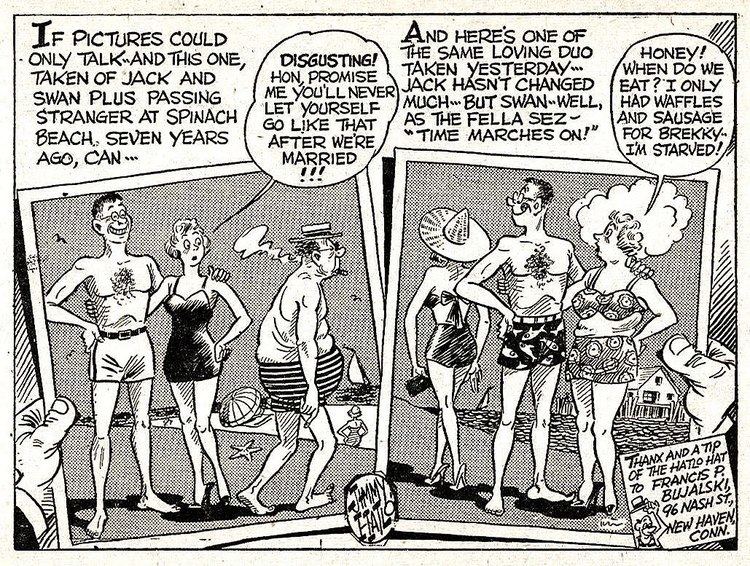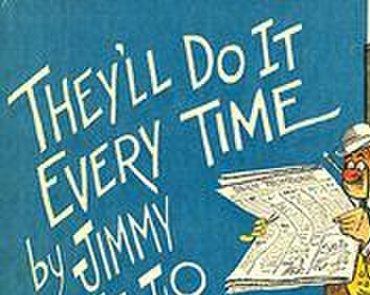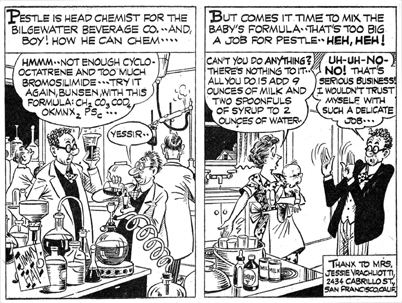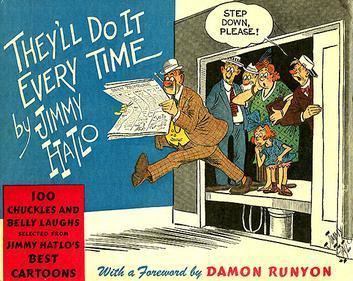Nationality American Parents James M. Hatlow | Name Jimmy Hatlo Area(s) Cartoonist Movies Little Iodine | |
 | ||
Born James Cecil Hatlo1 September 1897East Providence, Rhode Island ( 1897-09-01 ) Awards National Cartoonists Society's Newspaper Panel Cartoon Award, 1957 and 1959Siliver Lady Award Died December 1, 1963, Carmel-by-the-Sea, California, United States | ||
James Cecil Hatlo (September 1, 1897 – December 1, 1963), better known as Jimmy Hatlo, was an American cartoonist who created in 1929 the long-running comic strip and gag panel They'll Do It Every Time, which he wrote and drew until his death in 1963. Hatlo's other strip, Little Iodine, was adapted into a feature-length movie in 1946.
Contents
- Biography
- Early years
- World War I
- Tip of the Hatlo hat
- The Hatlo Inferno
- Books
- Popularity
- Personal life and death
- References

In an opinion piece for the July 22, 2013, Wall Street Journal, "A Tip of the Hat to Social Media's Granddad," veteran journalist Bob Greene characterized Hatlo's daily cartoons, which credited readers who contributed the ideas, as a forerunner of Facebook and Twitter. Greene wrote: "Hatlo's genius was to realize, before there was any such thing as an Internet or Facebook or Twitter, that people in every corner of the country were brimming with seemingly small observations about mundane yet captivating matters, yet lacked a way to tell anyone outside their own circles of friends about it. Hatlo also understood that just about everyone, on some slightly-below-the-surface level, yearned to be celebrated from coast to coast, if only for a day."

Biography

Hatlo was born in East Providence, Rhode Island, on September 1, 1897. His father, James M. Hatlow, a printer, was an immigrant from the Orkney Islands of Scotland. The original spelling of the family name became an inconvenience when, as a budding sports cartoonist, Hatlo fashioned a trademark signature with the "H" drawn as stylized goal posts and the "o" as a descending football. He shrank the "w" into a small apostrophe in the signature but otherwise dropped it entirely.
Early years

When he was a small child, the family moved to Los Angeles. As a young man, Hatlo began doing incidental artwork and engravings for local newspapers during an era when halftone reproduction of photographs was still limited.
World War I

When the United States entered World War I, Hatlo went to Kelly Field, hoping to become an aviator despite his poor eyesight. Instead he became a Spanish flu casualty and missed the war entirely.

He relocated to San Francisco following the war and worked for both the San Francisco Call & Post and the San Francisco Evening Bulletin. The two papers later merged as the San Francisco Call-Bulletin, part of William Randolph Hearst's publishing empire. Hatlo at first drew "travelogues" for automobile advertising. These illustrated maps promoted auto travel (and thus auto sales). On the strength of his talent, he soon managed to work his way into editorial cartooning and then sports cartooning. His sports cartoon for the Call-Bulletin was Swineskin Gulch.
Tip of the Hatlo hat
His break came when a shipment of panels from syndicated cartoonist Tad Dorgan failed to arrive in the mail. Hatlo was pressed into service to create something to fill the space. What resulted was They'll Do It Every Time, an instant hit with San Francisco readers. After several days, he began to run short on ideas. Various people—including Pat Frayne, Hatlo's managing editor at the time, and Scoop Gleason, his sports editor—later claimed credit for what happened next, but it may have been Hatlo himself who hit on the tactic of asking readers to submit their own ideas for the cartoons. Whatever the source, the gambit was a huge success. Hatlo picked the best submissions and credited each contributor by name, closing each cartoon with a box that read, "Thanx and a tip of the Hatlo Hat to..."
The Hatlo Inferno
They'll Do It Every Time became a fixture in the Call-Bulletin. It soon caught the attention of Hearst and was picked up by Hearst's King Features Syndicate. His supplemental panel, The Hatlo Inferno, which depicted life in Hell, ran in tandem with They'll Do It Every Time for five years (1953–58).
Books
Hatlo's first They'll Do It Every Time collection, a 100-page softbound book, was published in 1939 by David McKay Company of Philadelphia. It was followed in the 1940s by two McKay hardcover collections. Avon paperback collections of They'll Do It Every Time followed throughout the 1950s. In his foreword to the 1943 McKay collection, Damon Runyon wrote that years earlier he had unsuccessfully tried to persuade the New York American to lure Hatlo away from San Francisco, adding:
It is my opinion, that Hatlo is today one of the greatest cartoonists the newspaper business has ever produced. Certainly he is one of the most human, and humanness is the element that makes a great cartoonist... Hatlo's forte is mirroring every day people. He has marvelous insight into the minds and souls of folks we all know. He has a great ear for the common speech of the day. He knows our men and women as they are in their homes, in the street and under all conditions, the result of mingling with them and rubbing elbows with them. Hatlo pictures people as they are, not as they ought to be, or as he imagines them... I have known the work of all the great cartoonists of the past 30 odd years in the newspaper business—I have known many of them personally, though that is not germane to an appraisal of their work, and I believe that Jimmy Hatlo rightly belongs in the first rank with them. I believe, too, that his cartoons represent a contribution to the entertainment of the American people at this time that is unsurpassed in any field.Popularity
Hatlo's success also attracted imitators, and a rival syndicate (McClure Newspaper Syndicate) launched a clone cartoon by Harry Shorten and Al Fagaly titled There Oughta Be a Law!.
After World War II, Hatlo settled in Carmel-by-the-Sea, California, where he became part of a cartoonist community that included such artists as Gus Arriola, Frank O'Neal, Eldon Dedini and Hank Ketcham.
At their peak, Hatlo's cartoons appeared in over 400 newspapers worldwide. Little Iodine, a spin-off comic strip featuring a mischievous little girl who had become one of Hatlo's stock characters, even got her own series of comic books and a 1946 movie adaptation. Hatlo's popularity was at its highest in the early 1950s. He was profiled in a 1952 feature article in The Saturday Evening Post titled "He Needles the Human Race."
Personal life and death
Hatlo was a lifelong smoker, who once appeared in magazine and newspaper ads for Lucky Strike cigarettes, his favorite brand. He was troubled in his later years by atherosclerosis. In late November 1963, Hatlo was hospitalized for a kidney condition. He died of a stroke early on December 1, 1963, at the age of 66.
